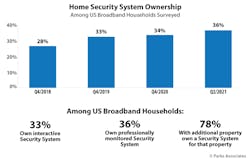The Smart Money: Residential Monitoring Advancements
This article originally appeared in the February 2022 issue of Security Business magazine. When sharing, don’t forget to mention Security Business magazine on LinkedIn and @SecBusinessMag on Twitter.
The security industry has grown and changed, but one thing remains the same: security system owners demand a swift, accurate, and effective response to issues.
In recent years, the industry has experienced substantial growth, as technology and homeowners’ changing lifestyles made the “peace of mind” value proposition more attractive. Now, with these new users onboard, responses to events that trigger alerts and alarms may make the difference when owners are considering the renewal of contracts and making recommendations to the next generation of new system owners.
Security system ownership is at an all-time high, as Parks Associates research reveals that more than 55% of each of the following key demographics own a security system:
- Households with children;
- Households with income of $100k or more;
- Those in the 35 to 44 age range; and
- Residents of urban areas.
Advancements in security system technology have enabled growth to trend with that of other connected devices, which have been growing particularly with affluent young adults and families. The lines are blurring between a security system and a smart home with security functionality. This evolution of the industry presents new opportunities and new competition.
Evolving Security Priorities
Priorities for monitoring continue to be focused on loved ones and prized possessions. The most successful security system providers going forward will be expanding their ability to monitor in and around the home but triggering fewer false alarms while they do it.
Some have already started on this expansion and refinement as recent releases from Alarm.com, Vivint and Ring include car security or collect information from car telematics. Additionally, HeimVision, EZVIZ, Reolink, and Abode all feature person detection technology that would differentiate between humans and other motion to reduce false alerts.
Beyond intrusion detection, system owners want monitoring for vehicle theft, trespassing, and fires. Parks Associates research shows that demographics play an influential role in the most important events to monitor after break-ins.
Our research finds that almost half of 18- to 24-year-olds choose stalking and harassment, and more than half of those 65 years and older choose fire as their top-priority events. Many of these security events occur in or around the exterior of the home, where the traditional window and door sensors cannot help.
Security system providers and platform-makers have an opportunity to bundle moisture sensors into their packages and include features like exterior monitoring via cameras and connecting to telematics to monitor and track vehicles.
Monitoring Expectations
More than half of security system owners have experienced a security event that could result in an action from a security system, and the monitoring service’s response influenced their satisfaction with the service.
Generally, system owners and service customers are happy with their monitoring service, though they note varying levels of ability to detect high-risk events such as gas leaks and intrusions, as well as events such as vehicle theft and water damage.
This shows that the response during an event is clearly a moment of truth. With nearly all security providers also offering professional monitoring in the industry today, companies who are juggling devices and services must keep event response a high priority.
False Alarms
Most owners say that two false alarms per year are too many, as false alarms have quickly become a source of frustration regardless of the type of alarm. Many owners – 65% – have paid a fine as a result. More than half of security system owners (53%) report that their systems misidentify pets, wildlife, and other moving objects as intruders.
Thus, reduction of false alarms is a major goal for device manufacturers in the space and involves some of the system’s most advanced technology. Still, the data indicates that consumer expectations are high.
Chris White is a Senior Analyst for market research firm Parks Associates, which has a wealth of research focused on consumer attitudes, preferences, and experiences in the smart home and security industry. To learn more, visit www.parksassociates.com, where you can also learn more about the upcoming CONNECTIONS: The Premier Connected Home Conference, which will hold in-person and virtual sessions throughout 2022.
About the Author

Chris White
Chris White is a Senior Analyst for market research firm Parks Associates. For more information on Parks Associates research, visit www.parksassociates.com.
